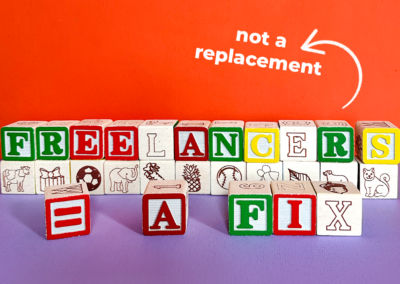Marnie Crawford didn’t enter the freelancing world voluntarily.
“I was laid off when I was expecting my oldest son,” she says. “I had every intention of being a working mom, but at seven months pregnant, it didn’t make sense for any companies to hire me.”
Then she found We Are Rosie, and as a member of our community of independent marketers, she began freelancing. “It enabled me to keep my foot in the door in the corporate world, and it also gave me the flexibility to be able to nurse my son and make dinner and everything else,” she says.
Four years later, Marnie is a client experience manager at We Are Rosie, which means she liaises between our community of marketing experts and the clients who hire them. Having been on both sides of the equation, she has insights into the needs of everyone involved. And when it comes to managing freelance talent, she says, it’s important to acknowledge that they are different from full-time employees.
If managing freelancers falls under your purview at work, consider these five strategies to ensure a healthy and productive partnership.
1. Know the freelancer’s goals
You know what you want to get out of this partnership, whether it’s a full product rebrand or just a skilled worker to keep things running during someone’s maternity leave.
“Freelancers are certainly quicker to hire and offer more flexibility than bringing on a full-time employee,” says Jordan Stella, head of product and marketing at the travel and adventure company, Let’s Roam, where he manages about 20 freelancers. “There’s the obvious cost savings, and freelancers can also pivot and take on new projects with ease.”
But what does the freelancer want from the relationship? Knowing the answer will put you on the right foot from the beginning.
“I’ve found that one of the biggest things freelancers want is flexibility,” Marnie says. “They don’t want to go to the office, whether it’s about avoiding the commute or making sure their kid gets off the bus. Or they might want to be deliberate in choosing work that they are very passionate about. Freelancers have voiced to me that full-time office work can get repetitive. With freelancing, they are able to pick things that light them up.”
So, how might understanding this affect your approach?
“As a manager of freelancers, you need to be flexible,” says Asha Akinyele, a people operations partner at We Are Rosie who helps make sure Rosies (aka our freelance marketers) are successful and happy with their projects.
“Freelancers are in this role because they want to choose their work schedule. You need to keep this in mind when you’re working on deliverables and projects—to be able to say, ‘This person is only available on certain days, so we need to communicate and re-route this particular work.’”
And as you get to know your freelance team and their passions, you can begin to figure out the most suitable projects for them. People do their best work when they’re engaged and interested in it, so consider this a win-win for everyone.
2. Set expectations
“Setting and maintaining expectations can become a major headache if you aren’t careful,” says Jordan, of Let’s Roam. “Establishing clear boundaries, timeframes, and quality standards up front keeps everyone honest and ensures a successful partnership.”
How do you do that, exactly?
“Clearly define the project,” says Asha. “We present the scope of the work and go over it in the interview process.”
She offers this example: Say you are hiring an independent marketer to conduct a social media campaign about Black History Month.
“We might have a 15-, a 30-, and a 90-day plan,” she says. “We’ll give the Rosie an outline and a schedule. Maybe during the first week, they’ll be working on, let’s say, increasing followers. Then we’ll list different tactics, like posting two to three posts per week or putting the brand out on different sites. Then, the following week, they might have paid promotions or paid sponsorships. And so on.”
3. Keep your freelancers in the loop
In Jordan’s experience, the most important part of managing freelancers is “establishing a system of communication that allows two-way feedback and keeps everyone up to speed on the latest information,” he says.
Obviously that’s a challenge when freelancers aren’t present at all meetings or sitting in the employee lounge (whether that’s in person or on Slack) when some tidbit of important information is casually shared. And when full-time employees have a question or concern, it’s often easy for them to run it by their manager while, say, passing them in the hallway or at the start of another meeting. Not so with freelancers and consultants.
“It’s easy to forget that freelancers need to communicate with managers as much as managers need to communicate with freelancers,” Jordan says. “We overcome this by treating them as much like regular employees as possible. We include them in meetings when necessary, we bring them into our company Slack team, and we make sure to keep a steady stream of communication. Even a quick check-in every few days can make a tremendous difference.”
Marnie suggests that you lock in the freelancer’s preferred method of communication, so messages don’t get missed.
“The work ebbs and flows and changes,” she says. “As things change, discuss preferred communication styles. Ask, ‘Do you want me to Slack you or would you prefer a text? Do you want the comments to be added to a Word doc or in an email?’ This isn’t someone who knows the company—they’re coming in fresh. So you’re creating a culture together, and aligning processes that aren’t in place.”
In other words, you can’t assume that your freelance talent already knows the company’s process for overtime or weekly one-on-ones. Your default position should be to always tell them a company policy like it’s the first time they’re hearing it. In many cases, it is.
“And freelancers should be able to connect with their team leader,” Asha advises. “Make yourself available. Encourage them to ask questions.”
4. Be intentional about giving feedback
Like all employees, Marnie says, “freelancers need to know how they are doing and whether they’re on the same page with your expectations.”
But it’s even more important for them because they don’t have the benefit of seeing how other employees are tackling projects and the reactions they’re getting. And in many cases, freelance team members don’t have a long history with the company. Everything might feel disconnected and new.
That’s why feedback is an important part of the experience at We Are Rosie. “We have whole guides on how to give feedback,” Asha says. “We have training on giving and receiving feedback.”
Asha’s team encourages We Are Rosie’s clients to reflect on their own feedback style as they work with Rosies.
“It’s nearly impossible for me to get every single person on the phone,” Asha says. “But if I can, I enjoy giving feedback verbally first. If a manager emails you and says, ‘Here is what you need to work on,’ without having a conversation first, that can leave a bad taste in a freelancer’s mouth.”
She says that as you get to know your freelancers and consultants, you’ll learn how they accept feedback. Use this knowledge to tailor your comments the next time.
“Some managers use the sandwich style,” she says. “You know, you start with a piece of bread, which is pointing out the opportunities for growth. Then you add something sweet—the jelly—which is complimenting them on what they did well. Then you follow up with another piece of bread, which might be the action items they can do to make the project better.”
But she admits that your freelancer might prefer that you’re more straight to the point. If that’s the case, simply adjust accordingly.
5. Treat them like first-stringers
No one wants to feel like they’re not really on the team—or just a second-string player on the sidelines. In truth, you probably couldn’t do what you do without your freelance talent. So to the best of your ability, let them know that.
“They’re not going to get company bonuses,” Asha explains. “But free swag like T-shirts, notebooks, or laptop decals might be nearly free for you and a nice touch. Or maybe on Valentine’s Day, we’ll send them a gift bag to make sure they feel included.”
She says that at We Are Rosie, freelancers supporting the core team join fun activities like virtual game nights or happy hours around the holidays. These events work well because they can be done remotely.
Of course, the greatest way to make a freelancer feel like part of the team is to pay them fairly, promptly and regularly. Full-time employees don’t have to worry about whether or not their paycheck will arrive; freelancers shouldn’t have to, either.
“Our Rosies are paid weekly,” Asha says. “We use a time tracking service called Harvest, and they submit timesheets, which are due by 11:59 pm on Sundays.”
As long as they do their part, Rosies receive their pay on that regular schedule.
“The only time they might be worried about getting paid is if they’ve missed the deadline to hand in their timesheets,” Asha says. Having worked as a freelancer in the past, she remembers from her own experience that this extra step can cause stress. “So even when they do miss the 11:59 pm deadline, I try to work with them!”
At We Are Rosie, everyone’s a team player. Bringing this approach to your workforce will help everyone thrive, whether they’re full-time, part-time, freelance, or somewhere in between.



